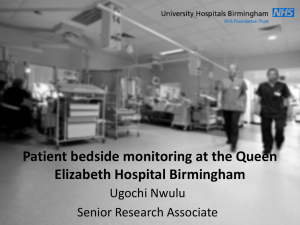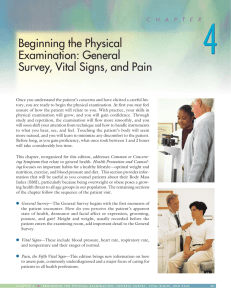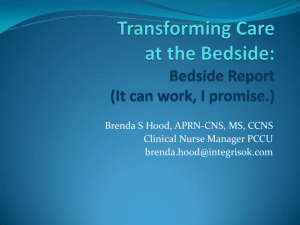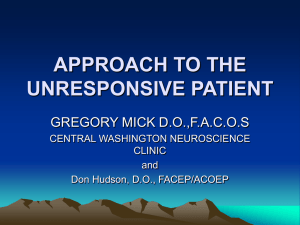RET 1024 Introduction to Respiratory Therapy
advertisement
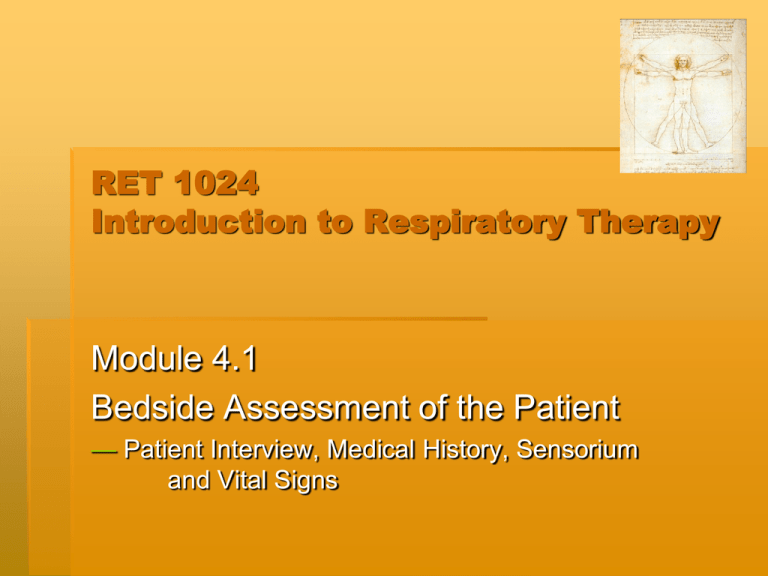
RET 1024 Introduction to Respiratory Therapy Module 4.1 Bedside Assessment of the Patient — Patient Interview, Medical History, Sensorium and Vital Signs Beside Assessment of the Patient RTs are playing an increasing role in the clinical decision-making process when it comes to initiating, adjusting, or discontinuing respiratory therapy. Bedside Assessment of the Patient As never before, RTs need to develop competent beside assessment skills in order gather and interpret relevant patient data Bedside Assessment of the Patient Bedside assessment is the process of interviewing the patient and examining the patient for signs and symptoms of disease and the effects of treatment Bedside Assessment of the Patient Two key sources of patient data Medical History Physical Examination Bedside Assessment of the Patient Medical History & Physical Examination Data gathered initially by the interview and physical examination help identify the need for subsequent diagnostic tests Bedside Assessment of the Patient Interviewing & Taking a Medical History 1. Provides patient perspective Subjective information 2. Establishes rapport between clinician and patient Facilitates the sharing of information and future evaluation and treatment plans 3. Obtains essential diagnostic information Objective information 4. Monitors changes in the patient’s symptoms and response to therapy Bedside Assessment of the Patient Interview skills are an art form that takes time and experience to develop Bedside Assessment of the Patient Patient interviews requires … A genuine concern for others “People don’t care how much you know until they know how much you care.” Theodore Roosevelt Empathy The ability to view the world from the patient’s perspective; recognition of the patient’s feelings without criticism - feeling with the patient Bedside Assessment of the Patient Patient interviews requires … The ability to listen Active; listening is not a passive activity Requires complete attention Preoccupation equates to missed information Includes observation of body language Facial expressions, eye movement, pain grimaces, restlessness, sighing Bedside Assessment of the Patient Structure and Technique for Interviewing Introduction Address patient by his or her surname, using Mr., Mrs., Senor, Senora. Introduce self and explain purpose of visit Observe social space; 4 – 12 feet away from patient Ensure privacy Pull curtains if in semi-private room Partially close door of room Prevent interruptions Bedside Assessment of the Patient Structure and Technique for Interviewing To Begin The Interview Move closer to patient; observe personal space; 2 – 4 feet Assume physical position at same level of patient (pull up a chair next to the bed) Use appropriate eye contact Bedside Assessment of the Patient Structure and Technique for Interviewing Questions and statements used in a conversational interview Closed Questions; focus on specific information, provide clarification “When did your cough start?” Open-ended questions; encourages patients to describe events and priorities as they see them, helping bring out concerns and attitudes and promote understanding “What brought you to the hospital” or “What happened next?” Bedside Assessment of the Patient Structure and Technique for Interviewing Questions and statements used in a conversational interview Indirect questions; less threatening because they sound like statements “If I understand you correctly, it is harder for you to breathe now than it was before your treatment.” Bedside Assessment of the Patient Structure and Technique for Interviewing Questions and statements used in a conversational interview Neutral questions; a subset of open-ended questions. They allow respondents to decide upon answers without overt direction or pressure from questioners Open Ended: “What happened next?” Closed: “Would you say that you expectorated a teaspoon, tablespoon, or half a cup?” (gives the patient a choice of responses while focusing on the type of information needed) Bedside Assessment of the Patient Structure and Technique for Interviewing Questions and statements used in a conversational interview Reflecting (echoing); repeating words, thoughts, or feelings that the patient just stated for purposes of clarifying or stimulating elaboration from the patient Facilitating phrases; e.g., “yes” or “I see” used with eye contact and perhaps nodding of the head, show interest and encourage patients to continue their story Bedside Assessment of the Patient Structure and Technique for Interviewing Questions and statements used in a conversational interview Communicating empathy (support); shows your concern for the patient as a human being “That must have been very difficult for you.” Bedside Assessment of the Patient Structure and Technique for Interviewing Alternate Sources for a Patient History Various factors affect the patient’s ability or willingness to provide an accurate history, e.g., age, alterations in level of consciousness, language, cultural barriers, emotional state, acuteness of the disease, etc. Bedside Assessment of the Patient Structure and Technique for Interviewing Alternate Sources for a Patient History In such cases, family members, friends, work associates, previous physicians, and past medical records often provide a more accurate picture of the history and progression of symptoms Bedside Assessment of the Patient Medical History Because dysfunctions of the respiratory system are often manifestations of other systemic disease processes, and because changes in pulmonary functions may affect other body systems, a cardiopulmonary assessment cannot be limited to the chest; a comprehensive evaluation of the patient’s entire health status is essential Bedside Assessment of the Patient Medical History Demographic data Name, Date of birth, Race, Religion, Occupation, Etc. Date and source of history and estimation of the reliability of the historian Patient’s condition at time of history Bedside Assessment of the Patient Medical History Chief complaint Reason for seeking treatment (admitting diagnosis) History of present illness Chronological description of each symptom Onset Frequency Location Severity Etc. Bedside Assessment of the Patient Medical History Past medical history Childhood diseases Hospitalization, surgeries, injuries, accidents Major illness Allergies Medications Family history Familial disease history Marital history Bedside Assessment of the Patient Medical History Social / environmental history Alcohol and cigarette consumption Occupational links to disease Gas / Chemical fumes Dusts Living arrangements Religious and social activities Recent travel or other event that might impact health Bedside Assessment of the Patient Medical History Review of systems Head-to-toe review of all body systems (done by a physician, located in “History & Physical section of chart) Eyes, ears, nose, mouth, throat Skin Cardiorespiratory system Digestive system Genitourinary system Endocrine system Nervous system … and more Bedside Assessment of the Patient Physical Examination Acute problem Abbreviated examination Stable More complex assessment Bedside Assessment of the Patient Physical Examination General Appearance Facial expression Pain Anxiety Alertness Mood Mental capacity Respiratory distress Bedside Assessment of the Patient Physical Examination General Appearance Diaphoresis (sweating) Fever Pain Severe stress Increased metabolism Acute anxiety Bedside Assessment of the Patient Physical Examination General Appearance Level of anxiety or distress Severity of current problem Position Pulmonary hyperinflation Upright, elbows braced on table Bedside Assessment of the Patient Physical Examination General Appearance Personal hygiene Duration and impact of illness on daily activities May indicated psychiatric disorder Nutritional status Well nourished or emaciated Bedside Assessment of the Patient Physical Examination Levels of Consciousness (common clinical terms for the varying levels of depressed consciousness) Conscious (alertness) Evaluate sensorium Oriented to Person, Place, Time (“oriented x 3”) Bedside Assessment of the Patient Physical Examination Levels of Consciousness (common clinical terms for the varying levels of depressed consciousness) May occur with: Poor cerebral blood flow or poorly oxygenated blood perfusing the brain (restless, confused, disoriented) Chronic degenerative brain disorders Medication side effects Drug overdose Bedside Assessment of the Patient Physical Examination Levels of Consciousness (common clinical terms for the varying levels of depressed consciousness) Confused Decrease of consciousness Slow mental responses Dulled perception Incoherent thoughts Delirious Hallucinations Easily agitated Irritable Bedside Assessment of the Patient Physical Examination Levels of Consciousness (common clinical terms for the varying levels of depressed consciousness) Lethargic Sleepy Arouses easily Responds appropriately when aroused Obtunded Awakens only with difficulty Responds appropriately when aroused Bedside Assessment of the Patient Physical Examination Levels of Consciousness (common clinical terms for the varying levels of depressed consciousness) Stuporous Does not awaken completely Decreased physical and mental activity Responds to pain and deep tendon reflexes Responds slowly to verbal stimuli Bedside Assessment of the Patient Physical Examination Levels of Consciousness (common clinical terms for the varying levels of depressed consciousness) Comatose Unconscious Does not respond to stimuli Does not move voluntarily Loss of reflexes with deep or prolonged coma Bedside Assessment of the Patient Physical Examination Vital Signs Body temperature Pulse rate Respiratory rate Blood pressure Pulse oximetry Considered the 5th vital sign in many patient care settings Bedside Assessment of the Patient Physical Examination Vital Signs An important part of the assessment process Most frequently used clinical measurements Provide useful information about patient’s clinical condition when compared with normal values and/or with a series of measurements Abnormal vital signs May be first clue to adverse reactions to treatment Improved vital signs Positive effects of treatment Bedside Assessment of the Patient Physical Examination Vital Signs Body Temperature Routinely measures for signs of inflammation or infection Core Temperature: Normal – 98.6 F (37 C) – “afebrile” Bedside Assessment of the Patient Physical Examination Vital Signs Body Temperature Hyperthermia – body temperature AKA: “fever” or “febrile” Increases metabolic rate ( oxygen consumption, CO2 production), accompanied by heart rate and ventilation to maintain homeostasis NOTE: This condition may eventually lead to respiratory failure Bedside Assessment of the Patient Physical Examination Vital Signs Body Temperature Hypothermia – body temperature Excessive heat loss (e.g., prolonged exposure to cold) Inadequate heat production Impaired hypothalamic thermoregulation (e.g., head injury, stroke) Bedside Assessment of the Patient Physical Examination Vital Signs Body Temperature Hypothermia – body temperature Decreased pulse and respiratory rate Patient indicates coldness Shivering (generates heat) Pale or bluish cool, waxy skin Hypotension Disorientation Drowsy or unresponsive Coma Bedside Assessment of the Patient Physical Examination Vital Signs Body Temperature Measured Rectum(reflects core temperature) Ear – tympanic membrane (reflects core temperature) Oral (most common), about 1 F lower than rectal temp Axilla (1 - 2 F lower than oral temp) Bedside Assessment of the Patient Physical Examination Vital Signs Pulse Rate Palpated at various sites Temporal Carotid Apical (heart) Brachial Radial Femoral Popliteal Posterior Tibial Dorsalis - Pedis Bedside Assessment of the Patient Physical Examination Vital Signs Pulse Rate Radial artery most common site to palpate pulse Use first, second, or third finger to palpate – not thumb Ideally, counted for 1 minute, but can be counted over 15 or 30 seconds and then multiplied appropriately to determine the pulse per minute Bedside Assessment of the Patient Physical Examination Vital Signs Pulse Rate Normal Rates New born (100 – 180 beats/min) Toddler (80 – 130 beats/min) Child (65 – 100 beats/min) Adult (60 – 100 beats/min) Bedside Assessment of the Patient Physical Examination Vital Signs Pulse Rate Bradycardia; < 60 beats/min Physically fit athletes Hypothermia Head injury Side effects of medication With certain cardiac arrhythmias Bedside Assessment of the Patient Physical Examination Vital Signs Pulse Rate Tachycardia; > 100 beats/min Exercise Fear, anxiety Low blood pressure (hypotension) Anemia Dehydration Fever Arterial blood oxygen (hypoxemia) Certain medications Bedside Assessment of the Patient Physical Examination Vital Signs Pulse Rate Note rhythm Normally, rhythm is regular Certain conditions such as inadequate blood flow and oxygen supply to the heart or an electrolyte imbalance, can cause the heart to beat irregularly Bedside Assessment of the Patient Physical Examination Vital Signs Pulse Rate Strength Reflects the strength of left ventricular contraction and volume of blood flowing to the peripheral tissues Should be strong and throbbing Bedside Assessment of the Patient Physical Examination Vital Signs Pulse Rate Strength Weak ventricular contractions combined with inadequate blood volume will result in in a weak thready pulse Increased heart rate combined with a large blood volume with generate a full, bounding pulse Bedside Assessment of the Patient Physical Examination Vital Signs Pulse Rate Pulsus paradoxus; pulse decreases markedly in strength during inspiration and returns to normal during exhalation – common among patients experiencing severe asthmatic episodes Pulsus alternans; strength of patient’s pulse varies every other beat while the rhythm remains regular (left-sided heart failure) Bedside Assessment of the Patient Physical Examination Vital Signs Respiratory Rate Normal resting rate Newborn (30 – 60 breaths/min) Toddler (25 – 40 breaths/min) Preschool (20 – 25 breaths/min) Adult (12 – 20 breaths/min) Bedside Assessment of the Patient Physical Examination Vital Signs Respiratory Rate Ideally counted when the patient is not aware Counted by watching the chest wall and abdomen move in and out One good method is to count the respiratory rate immediately after taking the pulse, while leaving the fingers over the patient’s artery Bedside Assessment of the Patient Physical Examination Vital Signs Respiratory Rate Tachypnea; abnormally high respiratory rate Exertion Fever Arterial hypoxemia Metabolic acidosis Anxiety Pain Bedside Assessment of the Patient Physical Examination Vital Signs Respiratory Rate Bradypnea; slow respiratory rate Head injuries Hypothermia Side effect of certain medications (narcotics) Severe myocardial infarction Drug overdose Bedside Assessment of the Patient Physical Examination Vital Signs Respiratory Pattern Apnea – no breathing Asthmatic breathing – prolonged exhalation Kussmaul’s – deep and fast (associated with diabetic acidosis) Bedside Assessment of the Patient Physical Examination Vital Signs Respiratory Pattern Cheyne-Stokes – increases and decreases in depth and rate with periods of apnea (low cardiac output as in CHF) Biot’s – similar to Cheyne-Stokes except tidal volumes are identical in depth (increased intracranial pressure) Bedside Assessment of the Patient Physical Examination Vital Signs Respiratory Rate Apneustic – sustained inspiratory effort (damage to pons associated with head trauma, severe brain hypoxemia, lack of blood flow to brain) Bedside Assessment of the Patient Physical Examination Vital Signs Blood Pressure (BP) Systolic pressure; peak pressure exerted in the arteries during contraction of the left ventricle Adult normal: 90 – 140 Diastolic pressure; pressure in arteries after relaxation of the ventricles Adult normal: 60 – 90 Pulse pressure; difference between systolic and diastolic blood pressure Adult normal: 35 – 40 Bedside Assessment of the Patient Physical Examination Vital Signs Blood Pressure (BP) Recorded as systolic / diastolic (e.g., 120/80 mm Hg) Hypertension; BP persistently elevated e.g., systolic > 140 or diastolic > 90 Factors associated with hypertension include arterial disease, obesity, a high serum sodium level, pregnancy, obstructive sleep apnea, a family history of high blood pressure Can cause headaches, blurred vision, confusion, renal failure (uremia), CHF, cerebral hemorrhage, leading to stroke Bedside Assessment of the Patient Physical Examination Vital Signs Blood Pressure (BP) Recorded as systolic / diastolic (e.g., 120/80 mm Hg) Hypertension Headaches Tinnitus (ringing in the ears) Light-headedness, confusion Easy fatigability Cardiac palpitations Blurred vision Renal failure (uremaia), CHF, cerebral hemorrhage, leading to stroke Bedside Assessment of the Patient Physical Examination Vital Signs Blood Pressure (BP) Recorded as systolic / diastolic (e.g., 120/80 mm Hg) Hypertension Hypertensive crisis; an acute, severe elevation of BP causing neurological, cardiac, and renal failure Sustained hypertension leads to thickening and inelasticity of the arterial walls and resistance to blood flow. This process in turn causes the left ventricle to distend and hypertrophy. Left ventricular hypertrophy may lead to congestive heart failure (CHF). Bedside Assessment of the Patient Physical Examination Vital Signs Blood Pressure (BP) Hypotension; BP < 90/60 mm Hg Blood pressure is not adequate for normal perfusion and oxygenation of vital organs Associated with peripheral vasodilation, decreased vascular resistance, hypovolemia, and left ventricular failure Analgesics (pain relievers) such as Demerol and morphine Severe burns Prolonged diarrhea and vommitting Bedside Assessment of the Patient Physical Examination Vital Signs Blood Pressure (BP) Postural hypotension; abrupt fall in BP when standing Occurs in hypovolemic patients May cause syncope (fainting) Confirmed by measuring BP in sitting and supine positions Treated with administration of fluid or vasoactive drugs Bedside Assessment of the Patient Physical Examination Measuring BP Commonly measured using auscultation Sphygmomanometer and stethoscope BP cuffs come in different sizes Bedside Assessment of the Patient Physical Examination Vital Signs Pulse oximetry SpO2 Bedside Assessment of the Patient Physical Examination Vital Signs Pulse oximetry Establishes an immediate baseline SpO2 value Excellent monitor by which to assess the patient’s response to respiratory care Adult normal: 95% - 99% Values between 91% - 94% represent mild hypoxemia May not require supplemental oxygen Values between 86% - 90% indicate moderate hypoxemia Requires supplemental oxygen Values below 85% indicate severe hypoxemia Warrant immediate medical attention Bedside Assessment of the Patient SpO2 and PaO2 Relationship for the Adult and Newborn Adult Oxygen Status Newborn SpO2 PaO2 SpO2 PaO2 Normal 95-99% 75-100 91-96% 60-80 Mild hypoxemia 91-94% 60-75 88-90% 55-60 Moderate hypoxemia 86-90% 50-60 85-89% 50-58 Severe hypoxemia <85% <50 <85% <50

